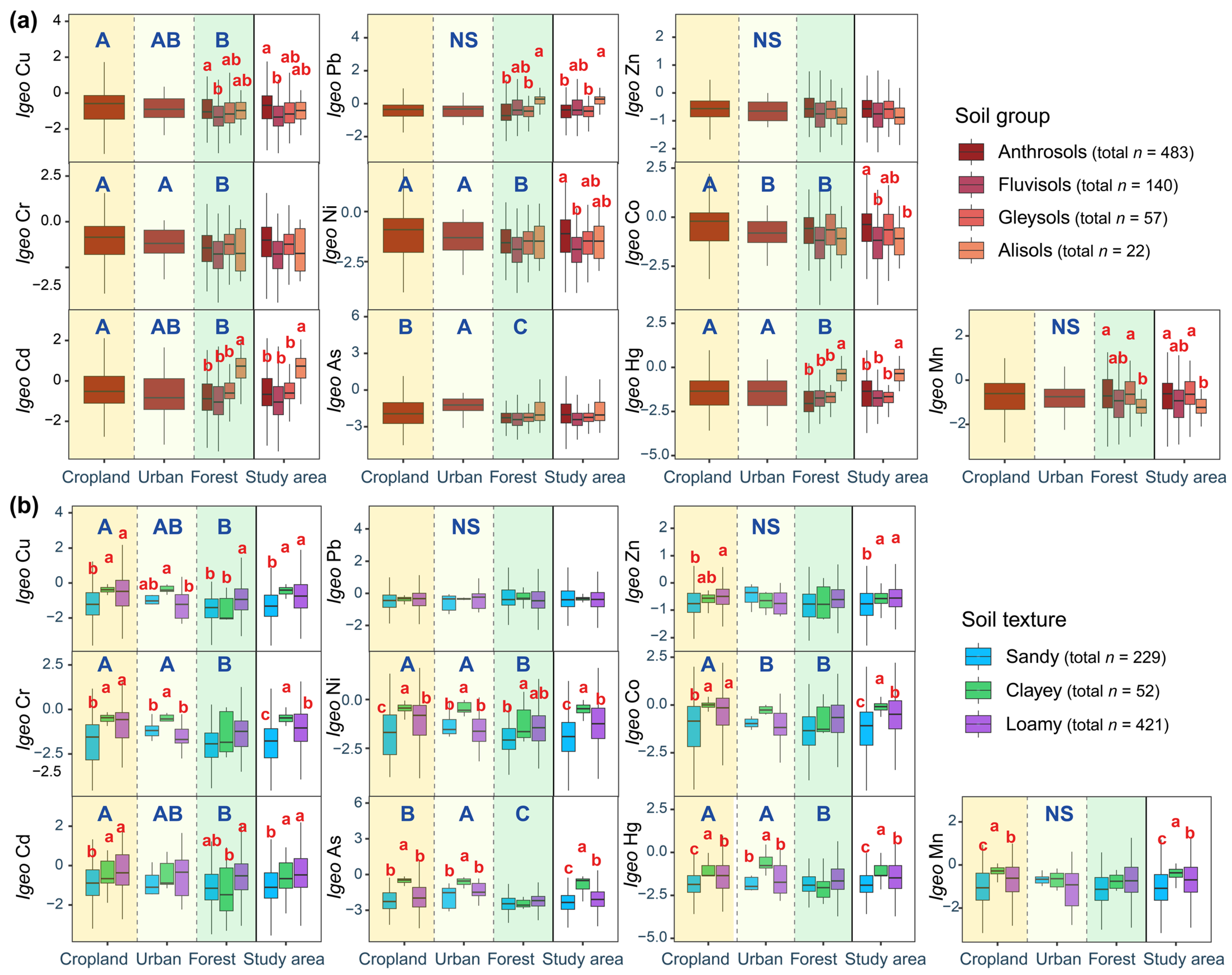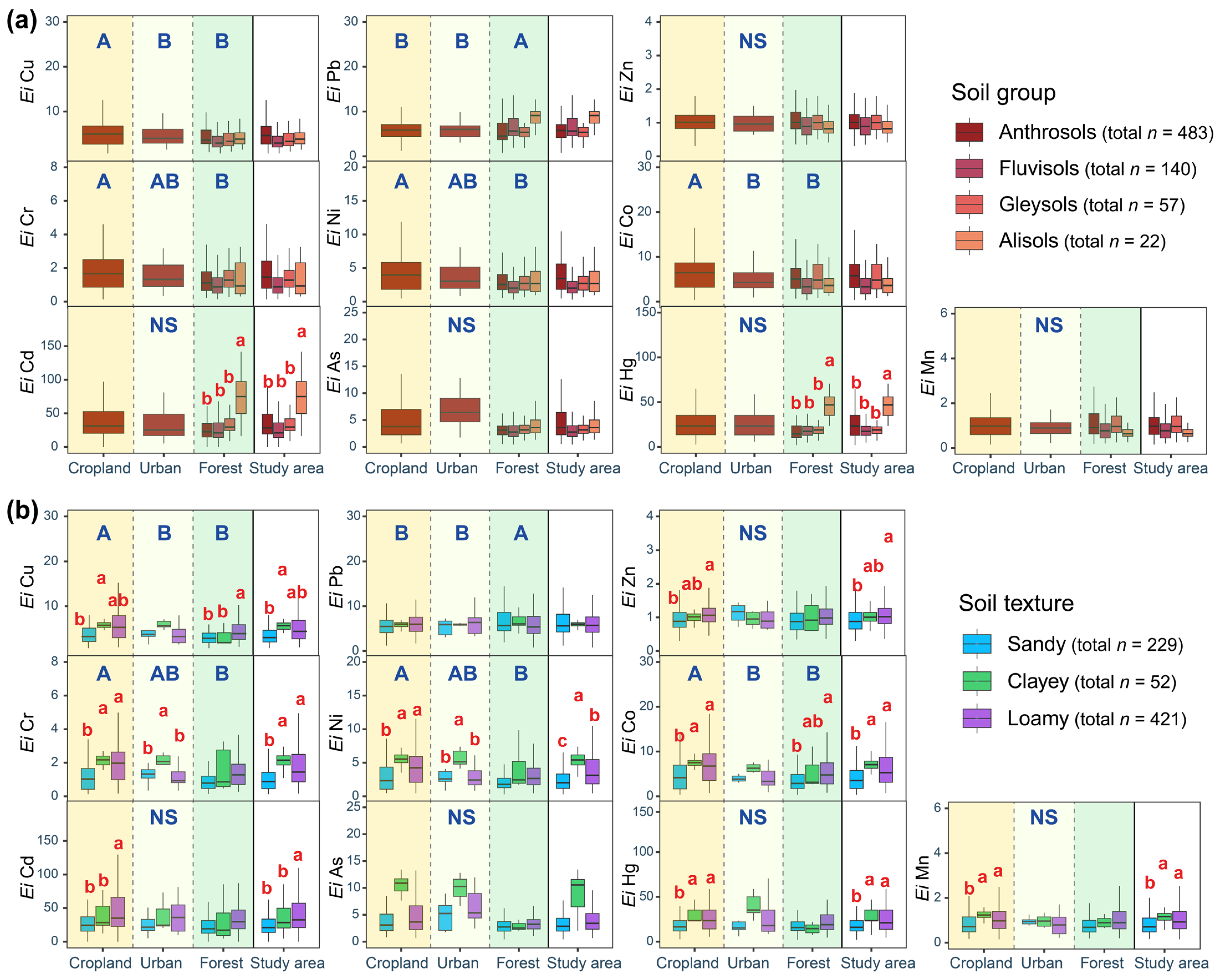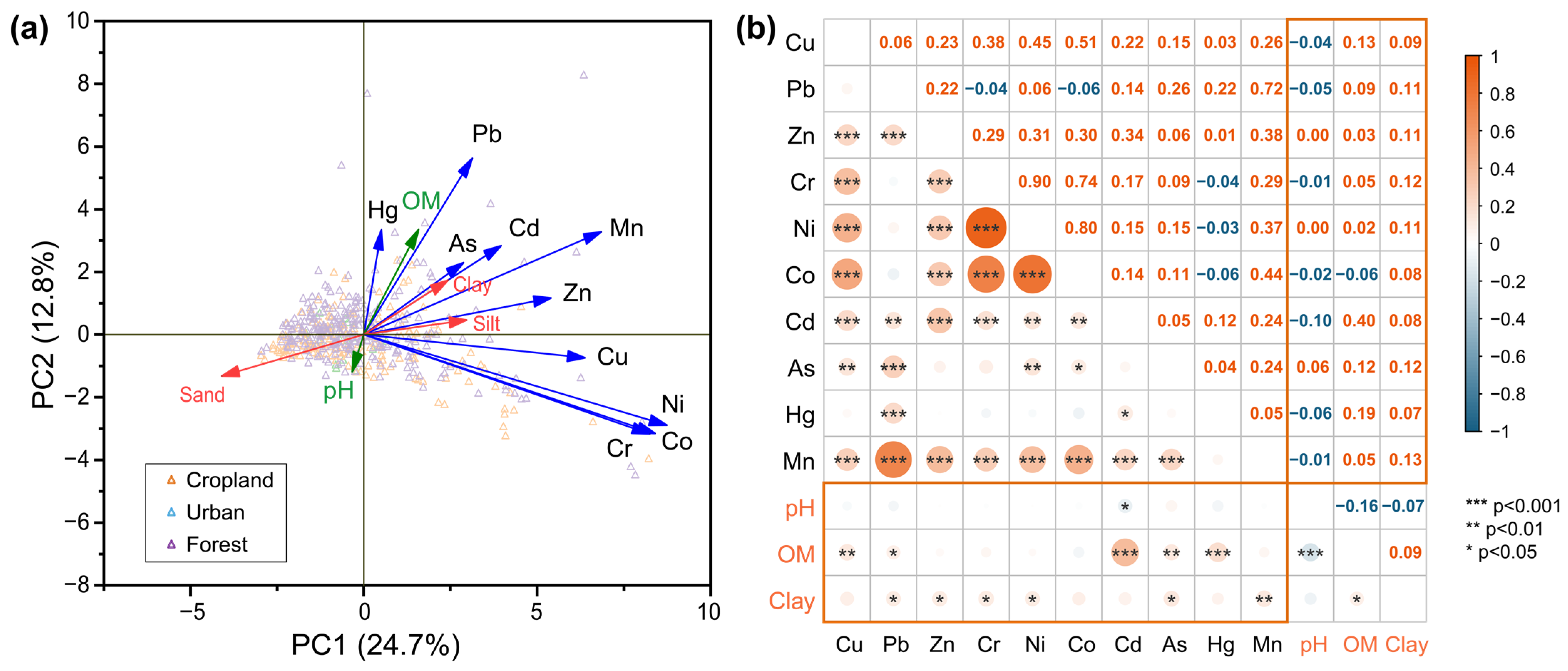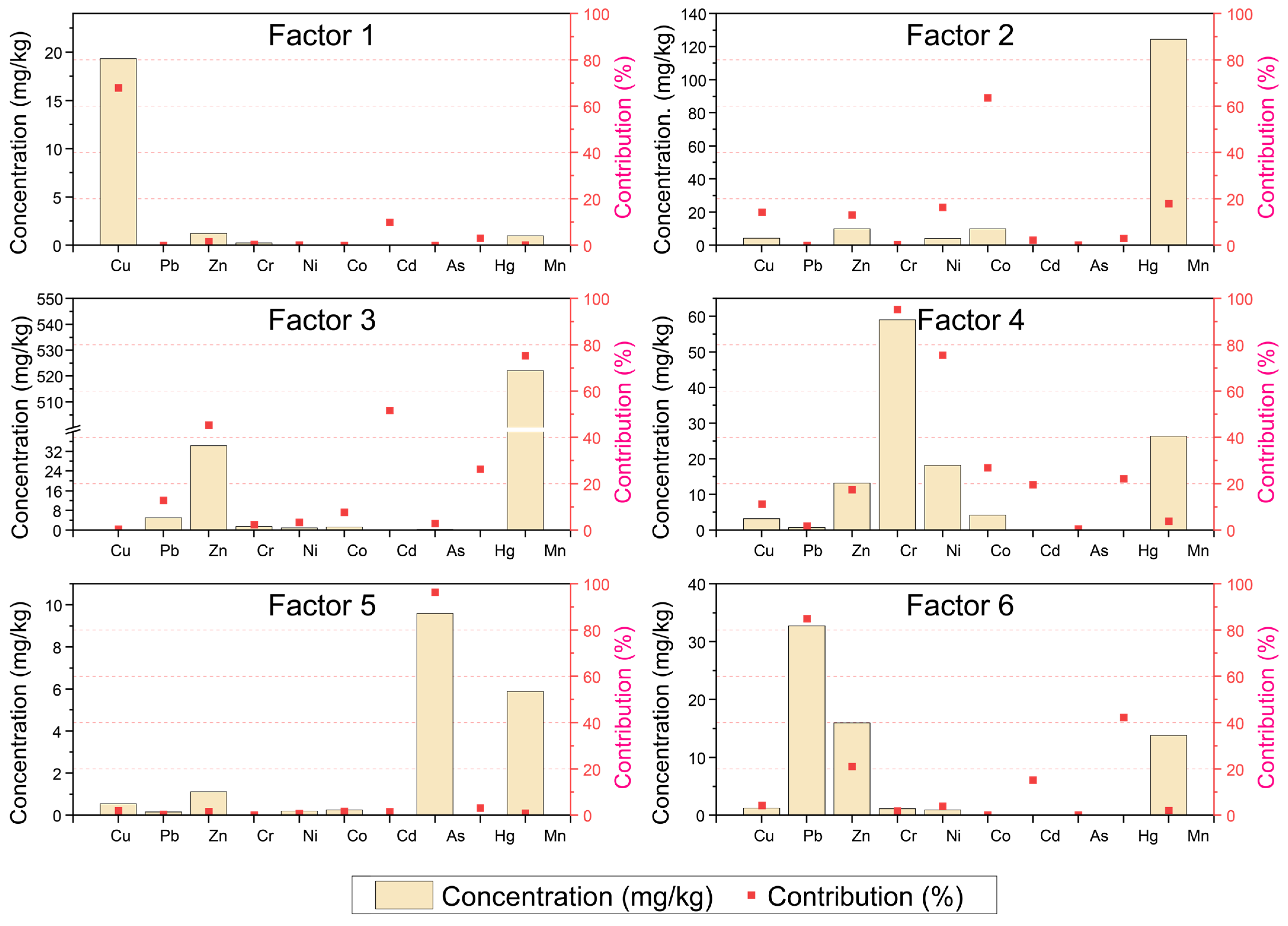Accumulation Pattern and Potential Ecological Risk of Heavy Metals in Topsoil as Affected by Diverse Sources in Different Ecosystems in Western Dabie Mountain
Abstract
1. Introduction
2. Materials and Methods
2.1. Study Area Description
2.2. Soil Sampling
2.3. Determination of Soil Physico-Chemical Properties and Heavy Metal Concentrations
2.4. Evaluation Methods for Heavy Metal Pollution
2.5. Performance of PMF
2.6. Statistical Analysis
3. Results
3.1. Soil Physico-Chemical Properties and Accumulation Characteristics of Heavy Metals
3.2. Pollution Status and Ecological Risk Assessment of Heavy Metals
3.3. Analysis of Heavy Metal Sources
4. Discussion
4.1. Pollution Status and Ecological Risk of Heavy Metals
4.2. Effects of Ecosystem and Soil Type on Heavy Metal Pollution Status and Ecological Risk
4.3. Main Sources of Heavy Metals
5. Conclusions
Author Contributions
Funding
Data Availability Statement
Acknowledgments
Conflicts of Interest
References
- Chen, L.; Luo, X.; He, H.; Duan, T.; Zhou, Y.; Yang, L.; Zeng, Y.; Chen, H.; Fang, L. Hg-mining-induced soil pollution by potentially toxic metal(loid)s presents a potential environmental risk and threat to human health: A global meta-analysis. Soil Ecol. Lett. 2024, 6, 240233. [Google Scholar] [CrossRef]
- Yaşar Korkanç, S.; Korkanç, M.; Amiri, A.F. Effects of land use/cover change on heavy metal distribution of soils in wetlands and ecological risk assessment. Sci. Total Environ. 2024, 923, 171603. [Google Scholar] [CrossRef] [PubMed]
- Du, H.; Wang, J.; Wang, Y.; Yao, Y.; Liu, X.; Zhou, Y. Contamination characteristics, source analysis, and spatial prediction of soil heavy metal concentrations on the Qinghai-Tibet Plateau. J. Soils Sediments 2023, 23, 2202–2215. [Google Scholar] [CrossRef]
- Hou, D.; O’Connor, D.; Nathanail, P.; Tian, L.; Ma, Y. Integrated GIS and multivariate statistical analysis for regional scale assessment of heavy metal soil contamination: A critical review. Environ. Pollut. 2017, 231, 1188–1200. [Google Scholar] [CrossRef]
- Mensah, A.K.; Addai, P. Cadmium, Cu, Hg, Sb, Se and Ti contamination in abandoned and active mining sites in Ghana shows concerns for soil and human health risks. Environ. Adv. 2024, 15, 100500. [Google Scholar] [CrossRef]
- Goncharov, G.; Soktoev, B.; Farkhutdinov, I.; Matveenko, I. Heavy metals in urban soil: Contamination levels, spatial distribution and human health risk assessment (the case of Ufa city, Russia). Environ. Res. 2024, 2024, 119216. [Google Scholar] [CrossRef]
- Suciu, N.A.; De Vivo, R.; Rizzati, N.; Capri, E. Cd content in phosphate fertilizer: Which potential risk for the environment and human health? Curr. Opin. Environ. Sci. Health 2022, 30, 100392. [Google Scholar] [CrossRef]
- Li, B.; Wu, G.; Yang, X.; Li, Z.; Albasher, G.; Alsultan, N.; Memon, A.A.; Afridi, H.I. Correlation of endocrine disrupting chemicals with essential elements in biological samples of children (1–5 years) with different infectious diseases and impact on sustainable outdoor activities. Environ. Res. 2023, 229, 115781. [Google Scholar] [CrossRef] [PubMed]
- Islam, M.S.; Nur-E-Alam, M.; Iqbal, M.A.; Khan, M.B.; Al Mamun, S.; Miah, M.Y.; Rasheduzzaman, M.; Appalasamy, S.; Salam, M.A. Spatial distribution of heavy metal abundance at distance gradients of roadside agricultural soil from the busiest highway in Bangladesh: A multi-index integration approach. Environ. Res. 2024, 250, 118551. [Google Scholar] [CrossRef] [PubMed]
- Banerjee, S.; Ghosh, S.; Jha, S.; Kumar, S.; Mondal, G.; Sarkar, D.; Datta, R.; Mukherjee, A.; Bhattacharyya, P. Assessing pollution and health risks from chromite mine tailings contaminated soils in India by employing synergistic statistical approaches. Sci. Total Environ. 2023, 880, 163228. [Google Scholar] [CrossRef]
- Oyebamiji, A.O.; Olaolorun, O.A.; Popoola, O.J.; Zafar, T. Assessment of heavy metal pollution in soils of Jebba Area, Nigeria: Concentrations, source analysis and implications for ecological and human health risks. Sci. Total Environ. 2024, 945, 173860. [Google Scholar] [CrossRef] [PubMed]
- Kim, S.; Jeong, S.; An, Y. Application of a soil quality assessment system using ecotoxicological indicators to evaluate contaminated and remediated soils. Environ. Geochem. Health 2020, 42, 1681–1690. [Google Scholar] [CrossRef] [PubMed]
- Askari, M.S.; Alamdari, P.; Chahardoli, S.; Afshari, A. Quantification of heavy metal pollution for environmental assessment of soil condition. Environ. Monit. Assess. 2020, 192, 162. [Google Scholar] [CrossRef]
- Chen, Z.F.; Ding, Y.F.; Jiang, X.Y.; Duan, H.J.; Ruan, X.L.; Li, Z.H.; Li, Y.P. Combination of UNMIX, PMF model and Pb-Zn-Cu isotopic compositions for quantitative source apportionment of heavy metals in suburban agricultural soils. Ecotoxicol. Environ. Saf. 2022, 234, 113369. [Google Scholar] [CrossRef] [PubMed]
- Singh, S.; Maiti, S.K.; Raj, D. An approach to quantify heavy metals and their source apportionment in coal mine soil: A study through PMF model. Environ. Monit. Assess. 2023, 195, 306. [Google Scholar] [CrossRef]
- Anaman, R.; Peng, C.; Jiang, Z.C.; Liu, X.; Zhou, Z.R.; Guo, Z.H.; Xiao, X.Y. Identifying sources and transport routes of heavy metals in soil with different land uses around a smelting site by GIS based PCA and PMF. Sci. Total Environ. 2022, 823, 153759. [Google Scholar] [CrossRef]
- Shao, F.; Li, K.; Ouyang, D.; Zhou, J.; Luo, Y.; Zhang, H. Sources apportionments of heavy metal(loid)s in the farmland soils close to industrial parks: Integrated application of positive matrix factorization (PMF) and cadmium isotopic fractionation. Sci. Total Environ. 2024, 924, 171598. [Google Scholar] [CrossRef]
- Zhou, H.; Yue, X.; Chen, Y.; Liu, Y. Source-specific probabilistic contamination risk and health risk assessment of soil heavy metals in a typical ancient mining area. Sci. Total Environ. 2024, 906, 167772. [Google Scholar] [CrossRef]
- Luo, X.; Bing, H.; Luo, Z.; Wang, Y.; Jin, L. Impacts of atmospheric particulate matter pollution on environmental biogeochemistry of trace metals in soil-plant system: A review. Environ. Pollut. 2019, 255, 113138. [Google Scholar] [CrossRef]
- Mai, X.; Tang, J.; Tang, J.; Zhu, X.; Yang, Z.; Liu, X.; Zhuang, X.; Feng, G.; Tang, L. Research progress on the environmental risk assessment and remediation technologies of heavy metal pollution in agricultural soil. J. Environ. Sci. 2025, 149, 1–20. [Google Scholar] [CrossRef]
- Yang, X.L.; Zhang, Q.Y.; Li, X.Z.; Jia, X.X.; Wei, X.R.; Shao, M.A. Determination of Soil Texture by Laser Diffraction Method. Soil Sci. Soc. Am. J. 2015, 79, 1556–1566. [Google Scholar] [CrossRef]
- Hakanson, L. An Ecological Risk Index for Aquatic Pollution Control—A Sedimentological Approach. Water Res. 1980, 14, 975–1001. [Google Scholar] [CrossRef]
- De Nicola, F.; Maisto, G.; Alfani, A. Assessment of nutritional status and trace element contamination of holm oak woodlands through analyses of leaves and surrounding soils. Sci. Total Environ. 2003, 311, 191–203. [Google Scholar] [CrossRef] [PubMed]
- Muller, G. Index of Geoaccumulation in Sediments of the Rhine River. GeoJournal 1969, 2, 109–118. [Google Scholar]
- Xu, Z.; Ni, S.; Tuo, X.; Zhang, C. Calculation of heavy metals’ toxicity coefficient in the evaluation of potential ecological risk index. Environ. Sci. Technol. 2008, 31, 112–115. [Google Scholar]
- Paatero, P. Least squares formulation of robust non-negative factor analysis. Chemom. Intell. Lab. Syst. 1997, 37, 23–35. [Google Scholar] [CrossRef]
- Paatero, P.; Tapper, U. Positive matrix factorization: A non-negative factor model with optimal utilization of error estimates of data values. Environmetrics 1994, 5, 111–126. [Google Scholar] [CrossRef]
- Background Values of Soil Elements in China; China Environmental Monitoring Station: Beijing, China, 1990. (In Chinese)
- Cheng, Y.; Zhao, Z.; Wang, Y.; Qiu, K.; Fu, Y.; Zhao, X.; Li, L. Soil Heavy Metals Pollution in the Farmland near a Lead Smelter in Henan Province. Chin. J. Soil Sci. 2014, 45, 1505–1510. (In Chinese) [Google Scholar]
- Chu, X.; Ma, Z.; Wu, D.; Wang, H.; He, J.; Chen, T.; Zheng, Z.; Li, H.; Wei, P. High Fe and Mn groundwater in the Nanchang, Poyang Lake Basin of China: Hydrochemical characteristics and genesis mechanisms. Environ. Monit. Assess. 2022, 195, 124. [Google Scholar] [CrossRef]
- Peana, M.; Pelucelli, A.; Chasapis, C.T.; Perlepes, S.P.; Bekiari, V.; Medici, S.; Zoroddu, M.A. Biological Effects of Human Exposure to Environmental Cadmium. Biomolecules 2023, 13, 36. [Google Scholar] [CrossRef]
- Yang, Y.; Liu, Y.; Li, Z.; Wang, Z.; Li, C.; Wei, H. Significance of soil microbe in microbial-assisted phytoremediation: An effective way to enhance phytoremediation of contaminated soil. Int. J. Environ. Sci. Technol. 2020, 17, 2477–2484. [Google Scholar] [CrossRef]
- Komárek, M.; Čadková, E.; Chrastný, V.; Bordas, F.; Bollinger, J.C. Contamination of vineyard soils with fungicides: A review of environmental and toxicological aspects. Environ. Int. 2010, 36, 138–151. [Google Scholar] [CrossRef] [PubMed]
- Marrugo-Negrete, J.; Pinedo-Hernández, J.; Díez, S. Assessment of heavy metal pollution, spatial distribution and origin in agricultural soils along the Sinú River Basin, Colombia. Environ. Res. 2017, 154, 380–388. [Google Scholar] [CrossRef] [PubMed]
- Palacios-Torres, Y.; de la Rosa, J.D.; Olivero-Verbel, J. Trace elements in sediments and fish from Atrato River: An ecosystem with legal rights impacted by gold mining at the Colombian Pacific. Environ. Pollut. 2020, 256, 113290. [Google Scholar] [CrossRef] [PubMed]
- Hu, X.; Wei, X.; Ling, J.; Chen, J. Cobalt: An Essential Micronutrient for Plant Growth? Front. Plant Sci. 2021, 12, 768523. [Google Scholar] [CrossRef] [PubMed]
- Yu, Q.; Wen, J.; Zhang, S.; Wu, C.; Ouyang, H.; Hu, N.; Li, X.; Qiu, X. The coupling of sulfide and Fe-Mn mineral promotes the migration of lead and zinc in the redox cycle of high pH floodplain soils. J. Hazard. Mater. 2024, 472, 134546. [Google Scholar] [CrossRef] [PubMed]
- Li, X.; Cao, Z.; Du, Y.; Zhang, Y.; Wang, J.; Ma, X.; Hu, P.; Luo, Y.; Wu, L. Multi-metal contaminant mobilizations by natural colloids and nanoparticles in paddy soils during reduction and reoxidation. J. Hazard. Mater. 2024, 461, 132684. [Google Scholar] [CrossRef] [PubMed]
- Shi, G.; Wang, X.; Wang, W.; Liu, D.; Liu, Q.; Zhou, J.; Chi, Q.; Liu, H. Nation-wide concentration and spatial distribution of manganese with links to manganese mineralization in China. J. Geochem. Explor. 2023, 244, 107130. [Google Scholar] [CrossRef]
- Han, R.; Liu, W.; Xu, Z. The constraint of soil Zn isotope compositions by diverse land utilizations: Evidence from geochemical fingerprint in a typical karst area. CATENA 2024, 240, 108005. [Google Scholar] [CrossRef]
- Sharifi, S.A.; Zaeimdar, M.; Jozi, S.A.; Hejazi, R. Effects of Soil, Water and Air Pollution with Heavy Metal Ions Around Lead and Zinc Mining and Processing Factories. Water Air Soil Pollut. 2023, 234, 760. [Google Scholar] [CrossRef]
- Wang, X.; Liu, Y.; Liu, B. Vertical migration in the soil of Cr(VI) and chromite ore processing residue: Field sampling and benchtop simulation. J. Hazard. Mater. 2023, 458, 132052. [Google Scholar] [CrossRef] [PubMed]
- Guria, M.K.; Guha, A.K.; Bhattacharyya, M. A green chemical approach for biotransformation of Cr(VI) to Cr(III), utilizing Fusarium sp. MMT1 and consequent structural alteration of cell morphology. J. Environ. Chem. Eng. 2014, 2, 424–433. [Google Scholar] [CrossRef]
- Hahn, J.; Mann, B.; Bange, U.; Kimmel, M. Horizon-specific effects of heavy metal mobility on nitrogen binding forms in forest soils near a historic smelter (Germany). Geoderma 2019, 355, 113895. [Google Scholar] [CrossRef]







| EF | Pollution Status | Igeo | Pollution Status | Ei | RI | Risk Level |
|---|---|---|---|---|---|---|
| ≤1 | No | ≤0 | No | <40 | <150 | Low |
| 1~2 | No to moderate | 0–1 | Slight | 40–80 | 150–300 | Moderate |
| 2~5 | Moderate | 1–2 | Slight to moderate | 80–160 | 300–600 | Moderate to high |
| 5~20 | Moderate to strong | 2–3 | Moderate | 160–320 | 600–1200 | High |
| 20~40 | Strong | 3–4 | Strong | >320 | >1200 | Very high |
| >40 | Extremely strong | 4–5 | Strong to very strong | |||
| ≥5 | Extremely strong |
| Anthrosols | Fluvisols | Gleysols | Alisols | Sandy | Clayey | Loamy | |
|---|---|---|---|---|---|---|---|
| Cropland (n = 350) | 350 (100%) | 0 | 0 | 0 | 104 (29.71%) | 36 (10.29%) | 210 (60.00%) |
| Urban (n = 32) | 32 (100%) | 0 | 0 | 0 | 8 (25.00%) | 8 (25.00%) | 16 (50.00%) |
| Forest (n = 320) | 101 (31.56%) | 140 (43.75%) | 57 (17.81%) | 22 (6.88%) | 117 (36.56%) | 8 (2.50%) | 195 (60.94%) |
| Total (n = 702) | 483 (68.80%) | 140 (19.94%) | 57 (8.12%) | 22 (3.13%) | 229 (32.62%) | 52 (7.41%) | 421 (59.97%) |
| Province | Soil Properties | Mean | Min. | Max. | Std. Deviation | CV (%) | Background Value for Soil Heavy Metal |
|---|---|---|---|---|---|---|---|
| Henan | Cu (mg/kg) | 35.35 | 5.35 | 484.00 | 47.44 | 134.20 | 19.70 |
| Pb (mg/kg) | 32.06 | 6.62 | 107.00 | 16.54 | 51.59 | 19.60 | |
| Zn (mg/kg) | 70.04 | 18.20 | 204.00 | 31.12 | 44.42 | 60.10 | |
| Cr (mg/kg) | 71.54 | 5.37 | 723.00 | 57.91 | 80.96 | 63.80 | |
| Ni (mg/kg) | 29.07 | 2.88 | 178.00 | 20.24 | 69.62 | 26.70 | |
| Co (mg/kg) | 16.13 | 0.70 | 84.00 | 12.33 | 76.43 | 10.00 | |
| Cd (mg/kg) | 0.15 | 0.03 | 0.48 | 0.10 | 65.44 | 0.07 | |
| As (mg/kg) | 20.15 | 1.51 | 1130.00 | 99.88 | 495.74 | 11.40 | |
| Hg (mg/kg) | 0.04 | 0.01 | 0.15 | 0.02 | 51.88 | 0.03 | |
| Mn (mg/kg) | 609.53 | 88.60 | 2080.00 | 368.17 | 60.40 | 579.00 | |
| Hubei | Cu (mg/kg) | 24.63 | 3.85 | 436.00 | 26.43 | 107.28 | 30.70 |
| Pb (mg/kg) | 41.74 | 4.09 | 1280.00 | 102.15 | 244.72 | 26.00 | |
| Zn (mg/kg) | 84.57 | 28.70 | 756.00 | 47.23 | 55.85 | 83.60 | |
| Cr (mg/kg) | 56.03 | 5.48 | 309.00 | 47.70 | 85.14 | 86.00 | |
| Ni (mg/kg) | 21.87 | 2.21 | 170.00 | 19.67 | 89.98 | 37.30 | |
| Co (mg/kg) | 15.20 | 1.04 | 71.80 | 11.39 | 74.95 | 15.40 | |
| Cd (mg/kg) | 0.16 | 0.00 | 2.38 | 0.17 | 103.77 | 0.17 | |
| As (mg/kg) | 4.25 | 0.53 | 40.80 | 3.71 | 87.36 | 12.30 | |
| Hg (mg/kg) | 0.04 | 0.00 | 0.90 | 0.06 | 156.93 | 0.08 | |
| Mn (mg/kg) | 740.79 | 133.00 | 7880.00 | 641.10 | 86.54 | 712.00 | |
| Study area | Cu (mg/kg) | 28.48 | 3.85 | 484.00 | 35.77 | 125.60 | 25.20 |
| Pb (mg/kg) | 38.27 | 4.09 | 1280.00 | 82.48 | 215.55 | 22.80 | |
| Zn (mg/kg) | 79.36 | 18.20 | 756.00 | 42.71 | 53.82 | 71.85 | |
| Cr (mg/kg) | 61.59 | 5.37 | 723.00 | 52.10 | 84.58 | 74.90 | |
| Ni (mg/kg) | 24.45 | 2.21 | 178.00 | 20.16 | 82.46 | 32.00 | |
| Co (mg/kg) | 15.53 | 0.70 | 84.00 | 11.73 | 75.55 | 12.70 | |
| Cd (mg/kg) | 0.16 | 0.00 | 2.38 | 0.14 | 92.75 | 0.12 | |
| As (mg/kg) | 9.96 | 0.53 | 1130.00 | 60.33 | 605.97 | 11.85 | |
| Hg (mg/kg) | 0.04 | 0.00 | 0.90 | 0.05 | 131.13 | 0.06 | |
| Mn (mg/kg) | 693.67 | 88.60 | 7880.00 | 561.92 | 81.01 | 645.50 | |
| pH | 5.99 | 4.12 | 8.78 | 0.78 | 12.95 | - | |
| Organic matter (%) | 1.88 | 0.35 | 9.86 | 1.53 | 81.14 | - |
| Ecosystems | Soil Groups | Soil Texture | ||||||||
|---|---|---|---|---|---|---|---|---|---|---|
| Cropland | Urban | Forest | Anthrosols | Fluvisols | Gleysols | Alisols | Sandy | Clayey | Loamy | |
| pH | 6.71 ± 0.01 b | 7.96 ± 0.09 a | 5.50 ± 0.02 c | 6.29 ± 0.03 a | 5.42 ± 0.03 b | 5.47 ± 0.05 b | 4.35 ± 0.02 c | 6.00 ± 0.05 b | 6.40 ± 0.07 a | 5.93 ± 0.04 b |
| Organic matter (%) | 1.70 ± 0.11 b | 1.46 ± 0.22 b | 2.03 ± 0.10 a | 1.89 ± 0.50 a | 2.20 ± 0.43 a | 2.02 ± 0.38 a | 1.69 ± 0.36 a | 1.51 ± 0.10 a | 1.74 ± 0.57 a | 2.13 ± 0.10 a |
| Clay (%) | 24.61 ± 2.71 a | 20.55 ± 0.61 b | 18.66 ± 0.48 b | 20.41 ± 0.52 a | 18.47 ± 0.63 a | 19.10 ± 1.25 a | 19.12 ± 2.15 a | 12.14 ± 0.32 c | 41.59 ± 1.99 a | 21.40 ± 0.36 b |
| Cu (mg/kg) | 23.30 ± 1.36 a | 16.93 ± 1.66 b | 25.95 ± 1.92 b | 30.71 ± 1.71 a | 23.94 ± 3.16 ab | 25.52 ± 2.19 ab | 16.11 ± 1.45 b | 20.28 ± 1.05 b | 21.88 ± 0.62 b | 33.76 ± 2.14 a |
| Pb (mg/kg) | 29.45 ± 1.71 b | 25.21 ± 1.83 b | 50.58 ± 8.07 a | 29.98 ± 0.89 b | 66.04 ± 14.93 a | 41.30 ± 5.76 ab | 35.45 ± 2.13 ab | 36.68 ± 2.39 a | 24.80 ± 0.77 a | 40.79 ± 5.02 a |
| Zn (mg/kg) | 84.83 ± 4.54 a | 76.64 ± 5.38 a | 84.89 ± 2.42 a | 79.52 ± 2.02 a | 79.62 ± 3.63 a | 86.19 ± 3.94 a | 56.38 ± 4.92 b | 73.58 ± 2.09 ab | 63.54 ± 2.23 b | 84.45 ± 2.38 a |
| Cr (mg/kg) | 58.42 ± 4.12 a | 43.44 ± 4.65 b | 55.26 ± 2.76 b | 65.51 ± 2.48 a | 48.61 ± 3.72 ab | 67.19 ± 6.44 a | 43.83 ± 7.09 b | 44.57 ± 2.49 b | 67.81 ± 2.68 a | 70.09 ± 2.88 a |
| Ni (mg/kg) | 22.36 ± 1.54 a | 16.42 ± 1.75 ab | 21.88 ± 1.23 b | 25.91 ± 0.89 a | 20.46 ± 1.91 a | 24.11 ± 2.50 a | 18.82 ± 3.04 a | 18.49 ± 1.10 b | 29.11 ± 1.06 a | 27.12 ± 1.08 a |
| Co (mg/kg) | 15.86 ± 0.90 a | 10.02 ± 0.89 b | 15.09 ± 0.70 ab | 16.46 ± 0.53 a | 12.74 ± 1.00 ab | 17.11 ± 1.59 a | 8.79 ± 1.28 b | 12.55 ± 0.73 b | 14.38 ± 0.44 ab | 17.29 ± 0.60 a |
| Cd (mg/kg) | 0.14 ± 0.01 ab | 0.12 ± 0.02 b | 0.17 ± 0.01 a | 0.15 ± 0.01 a | 0.16 ± 0.01 a | 0.19 ± 0.01 a | 0.19 ± 0.02 a | 0.13 ± 0.01 b | 0.10 ± 0.01 b | 0.18 ± 0.01 a |
| As (mg/kg) | 4.21 ± 0.35 a | 5.75 ± 0.66 a | 4.18 ± 0.19 a | 12.21 ± 3.30 a | 5.14 ± 0.55 a | 4.09 ± 0.22 a | 6.28 ± 1.36 a | 4.54 ± 0.30 a | 10.38 ± 0.53 a | 12.85 ± 3.79 a |
| Hg (mg/kg) | 0.03 ± 0.00 b | 0.03 ± 0.00 ab | 0.04 ± 0.00 a | 0.03 ± 0.00 a | 0.05 ± 0.01 a | 0.04 ± 0.00 a | 0.04 ± 0.00 a | 0.03 ± 0.00 a | 0.03 ± 0.00 a | 0.04 ± 0.00 a |
| Mn (mg/kg) | 725.86 ± 30.50 a | 617.44 ± 66.78 a | 757.75 ± 47.33 a | 689.76 ± 17.77 a | 724.51 ± 83.92 a | 768.26 ± 49.69 a | 390.09 ± 29.40 b | 587.66 ± 24.65 b | 680.33 ± 21.80 ab | 752.98 ± 32.28 a |
Disclaimer/Publisher’s Note: The statements, opinions and data contained in all publications are solely those of the individual author(s) and contributor(s) and not of MDPI and/or the editor(s). MDPI and/or the editor(s) disclaim responsibility for any injury to people or property resulting from any ideas, methods, instructions or products referred to in the content. |
© 2024 by the authors. Licensee MDPI, Basel, Switzerland. This article is an open access article distributed under the terms and conditions of the Creative Commons Attribution (CC BY) license (https://creativecommons.org/licenses/by/4.0/).
Share and Cite
Yang, T.; Wu, F.; Luo, M.; Xiong, J.; Nie, X.; Cao, F.; Ruan, Y.; Li, F.; Huang, W.; Liang, T.; et al. Accumulation Pattern and Potential Ecological Risk of Heavy Metals in Topsoil as Affected by Diverse Sources in Different Ecosystems in Western Dabie Mountain. Forests 2024, 15, 1116. https://doi.org/10.3390/f15071116
Yang T, Wu F, Luo M, Xiong J, Nie X, Cao F, Ruan Y, Li F, Huang W, Liang T, et al. Accumulation Pattern and Potential Ecological Risk of Heavy Metals in Topsoil as Affected by Diverse Sources in Different Ecosystems in Western Dabie Mountain. Forests. 2024; 15(7):1116. https://doi.org/10.3390/f15071116
Chicago/Turabian StyleYang, Tao, Feng Wu, Minxuan Luo, Jiatai Xiong, Xiaoli Nie, Fan Cao, Yunzhao Ruan, Fu Li, Wubiao Huang, Tao Liang, and et al. 2024. "Accumulation Pattern and Potential Ecological Risk of Heavy Metals in Topsoil as Affected by Diverse Sources in Different Ecosystems in Western Dabie Mountain" Forests 15, no. 7: 1116. https://doi.org/10.3390/f15071116
APA StyleYang, T., Wu, F., Luo, M., Xiong, J., Nie, X., Cao, F., Ruan, Y., Li, F., Huang, W., Liang, T., & Yang, Y. (2024). Accumulation Pattern and Potential Ecological Risk of Heavy Metals in Topsoil as Affected by Diverse Sources in Different Ecosystems in Western Dabie Mountain. Forests, 15(7), 1116. https://doi.org/10.3390/f15071116








